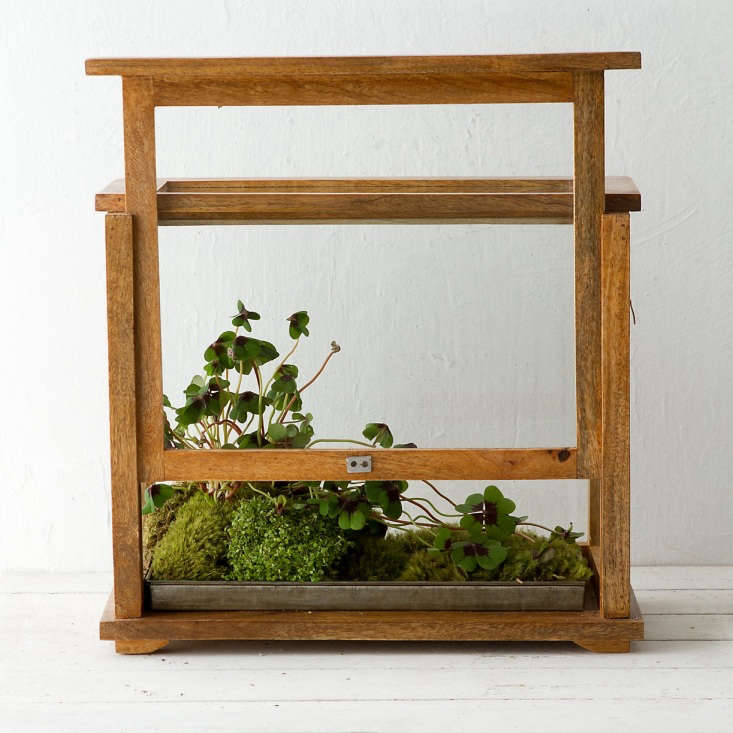Terrariums are billed as the ultimate no-maintenance houseplant setup, so it’s not surprising that many newbie terrarium owners are a little miffed when, a few months in, things start going wrong.
Perhaps the glass is misty and filmed with a green goo. Or the once-neat foliage of a fern has grown so much that it is threatening to push up the lid and smother the other plants. Or, worse of all, there’s just a pile of brown, moldy mush where a succulent once stood.
While there are many terrarium websites and books full of terrarium projects to undertake, few address in detail how to troubleshoot problems, or acknowledge that even the most carefully planted terrarium will probably need a revamp once or even twice a year. This partly depends on the size of the container: as botanist James Wong, pointed out recently, a terrarium of at least 30 by 30 centimeters (approximately 12 by 12 inches) is far more likely to create a stable, long-term environment for plants. You can keep plants in smaller glass containers than that: just don’t expect them to look exactly the same in a year.
Here are the six most common problems, and how to fix them:
The Glass Is Constantly Misty

The glass of a closed terrarium should go through a daily cycle of misting up and clearing: this is totally normal, even if the terrariums you ogle on Instagram always have crystal clear glass. But if the glass is constantly covered in condensation, try taking off the lid or cracking open a vent for a few hours, until the glass clears. You may need to do this over a period of days until things settle down: for a quick fix, use a soft cloth to mop up the condensation. Be careful, though: plants used to the high humidity of a terrarium interior may wilt when exposed to dry air.
The Glass is Dirty

If your glass is green, it’s a sign that algae has started setting up home. If you have a large tank-style aquarium with flat sides, you can use an aquarium scraper or even an old credit card to remove algae easily. On curved glass, paper towels or a clean rag are perfect. White streaks are usually caused by mineral deposits caused by watering with tap water; if you can, use rainwater or distilled water to fix the problem. You may be able to wipe away the streaks with a cloth dampened with lemon juice or vinegar (keep this well away from your plants). Then follow up with a cloth dipped in rainwater or distilled water. If that doesn’t work, you’ll need to take apart the terrarium, clean the glass thoroughly with vinegar, rinse, and reassemble.
The Plants Are Overgrown

Most plants will fill out their allotted space in a terrarium within a matter of months if they are happy. First, try giving them a prune, carefully trimming away leaves that touch the glass or encroach upon their neighbors. If this seems too massive a task, or the plants end up looking messy, it’s probably time to liberate them to another spot and replace with something smaller and slower-growing: nerve plant (Fittonia), Sonerila, parlor palm (Chamaedorea elegans), and Cryptanthus (earth star) are all great options.
The Plants Are Leaning to One Side

Your specimens are probably trying to grow towards the light source. Turn your terrarium slightly every few days so that the plants all get the same exposure to light, and if they get leggy, move the terrarium to a brighter spot, still out of direct sunlight.
Mold or Fungus Is Growing

High humidity levels make perfect conditions for molds and fungi to establish, especially if terrariums are overcrowded. Nip problems in the bud by promptly removing any dead or dying foliage and by keeping the glass clean. If it’s too far gone, empty out the whole thing and start again. Hygiene is vital when planting a terrarium; start by washing containers out with hot soapy water. Then rinse thoroughly and allow the terrarium to air dry; some growers even recommend using a microwave to sterilize soil before planting. Adding a layer of activated charcoal below the compost will help to keep problems at bay.
Succulents and Cacti Have Rotted Away

Open terrariums for desert-dwelling plants are very popular, but keeping cacti and succulents happy in a container with no drainage requires a knife-edge watering technique: too little and the plants won’t grow, or worst-case scenario, will shrivel. Too much root rot will set in suddenly and terminally. If succulent plants are rotting at the base, you may be able to take a cutting from the healthy top section, allow it to callus over, and replant in a regular pot. Either way, you will need to empty and revamp the terrarium. Consider replanting with something more terrarium-friendly, such as bromeliads, ferns, mosses, and small-leaved begonias.
More Help: Terrarium Workshops

- In London, London Terrariums offers regular workshops; a Tinyjohn Workshop on January 7 is £45.
- In Brooklyn, Sprout Home’s next Terrariums Workshop will be on January 10; $75.
- In Chicago, Sprout Home’s next Terrariums Workshop will be on December 13; $75.
- In Rochester, NY, a Winter-Themed Succulent Gardens Terrarium Workshop will be on December 7; $30.
- In Portland, Oregon, Pistils Nursery is offering a Terrarium Building Workshop on December 19; $25.
N.B.: Get more terrarium tips:
- The New Terrarium: 6 Top Trends for 2018.
- Gardening 101: How to Plant an Open Terrarium.
- 10 Easy Pieces: Glass Cloche Terrariums.









Have a Question or Comment About This Post?
Join the conversation